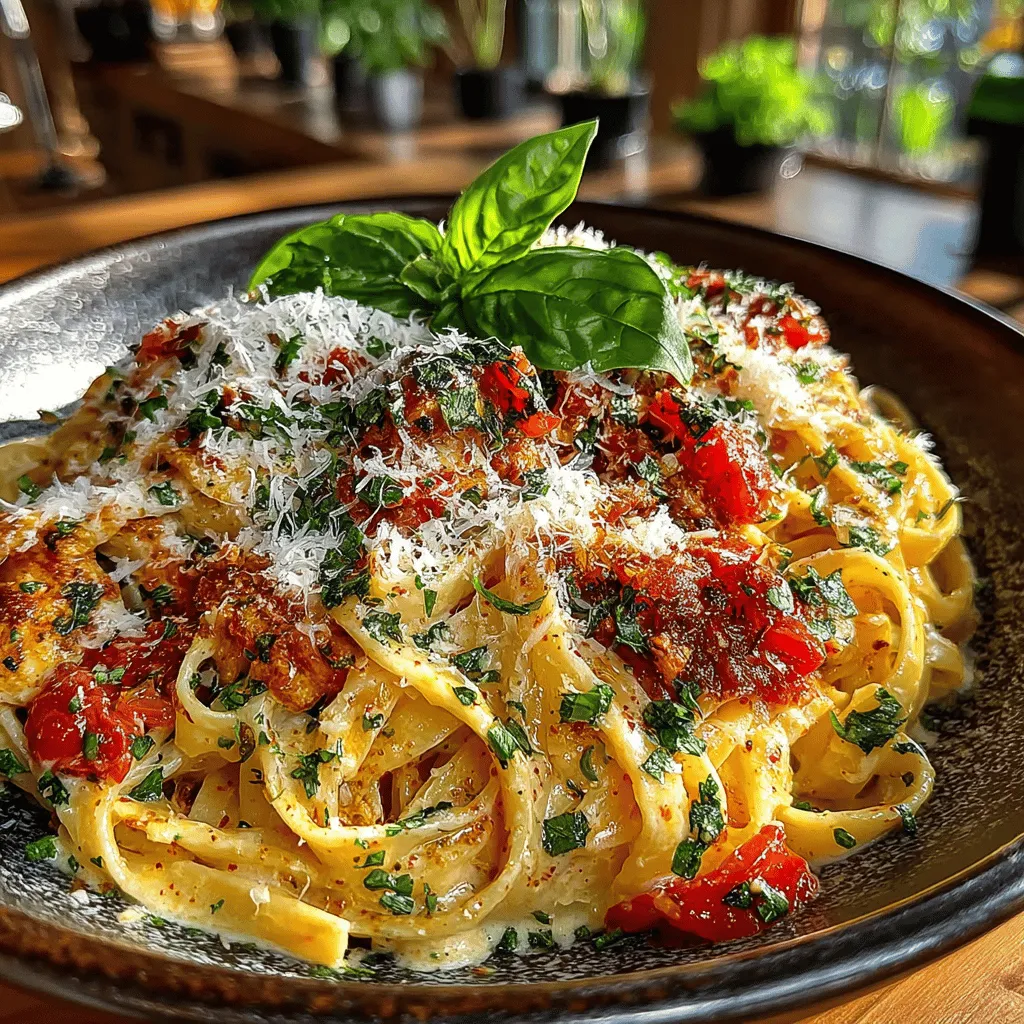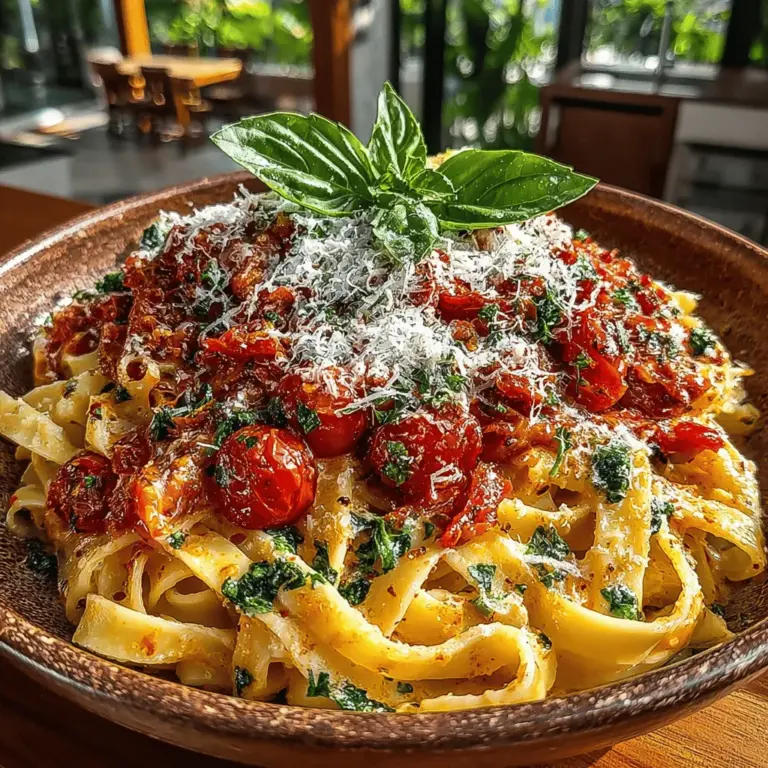Creamy Tomato Basil Pasta: A Comfort Food Classic
Creamy Tomato Basil Pasta is a dish that embodies the essence of comfort food, combining rich flavors with a luscious texture that envelops every bite. This recipe is not only a feast for the palate but also an invitation to gather around the dining table with family and friends. It’s the kind of dish that transforms a simple weeknight dinner into a special occasion, celebrating the joy of home-cooked meals. The creamy sauce, infused with fresh basil and vibrant tomatoes, offers a delightful balance that pleases even the pickiest eaters.
Comfort food plays a crucial role in our everyday cooking by providing a sense of warmth and familiarity. After a long day, there’s nothing quite like the satisfaction of a hearty meal that feels both indulgent and nourishing. Creamy Tomato Basil Pasta fits this description perfectly; it’s straightforward enough for novice cooks yet sophisticated enough to impress guests. The combination of creamy sauce, aromatic herbs, and perfectly cooked pasta creates a comforting dish that evokes feelings of nostalgia and happiness.
The appeal of this pasta dish lies not only in its comforting nature but also in the freshness of its ingredients. The creamy texture derived from heavy cream complements the acidity of tomatoes, while fresh basil adds a fragrant note that elevates the entire experience. Each component plays a vital role in creating a harmonious blend of flavors that is both satisfying and memorable.
Understanding the Ingredients
To create the perfect Creamy Tomato Basil Pasta, understanding the ingredients is key. The primary components include pasta, canned or fresh tomatoes, heavy cream, garlic, olive oil, and fresh basil. Each ingredient contributes to the dish’s overall flavor profile, making it essential to choose high-quality products.
Pasta Choice: When it comes to pasta, the choice between fettuccine and penne can significantly impact the dining experience. Fettuccine, with its wide, flat shape, allows the creamy sauce to cling beautifully, ensuring every bite is drenched in flavor. On the other hand, penne, with its tubular structure, captures the sauce within its ridges, providing a delightful textural contrast. Ultimately, the choice comes down to personal preference, but both options offer a fantastic foundation for this dish.
The Role of Olive Oil, Garlic, and Heavy Cream: Olive oil is not just a cooking medium but also a flavor enhancer that adds richness to the dish. It helps to sauté the garlic, releasing its aromatic qualities and infusing the oil with flavor. Garlic is a staple in many Italian dishes, and in this recipe, it serves as a foundational ingredient that adds depth to the sauce. Heavy cream is what makes the sauce luxuriously creamy, balancing the acidity of the tomatoes and creating a velvety texture that coats the pasta perfectly.
Fresh vs. Dried Herbs: When it comes to herbs, fresh basil is the star of the show. Its vibrant flavor is unmatched by dried herbs, making it essential for this dish. Fresh basil adds a burst of color and aroma, enhancing the overall experience. While dried herbs can be a convenient alternative, they often lack the brightness and intensity that fresh herbs bring to the table.
Cooking the Perfect Pasta
The first step in preparing Creamy Tomato Basil Pasta is cooking the pasta, and this process is crucial for achieving the best results. Salting the pasta water is an essential step that enhances the flavor of the pasta itself. A well-salted pot of boiling water not only seasons the pasta but also contributes to the overall taste of the dish. Aim for a ratio of about 1 tablespoon of salt per gallon of water, ensuring that the pasta absorbs enough flavor as it cooks.
Al Dente Texture: Achieving the perfect al dente texture is vital for pasta dishes. Al dente means “to the tooth” in Italian, and it refers to pasta that is cooked until it is firm to the bite. This texture allows the pasta to hold up well when combined with the creamy sauce, preventing it from becoming mushy. To ensure you hit that sweet spot, begin tasting the pasta a minute or two before the package instructions indicate. You want it to be tender yet still have a slight bite.
Draining Pasta Without Losing Flavor: Once the pasta is cooked to perfection, it’s important to drain it without losing any of the flavor. Avoid rinsing the pasta, as this washes away the starch that helps the sauce adhere. Instead, use a colander to drain the pasta, reserving a cup of the pasta water. This starchy water can be a valuable addition to your sauce, helping to achieve the desired consistency while enhancing flavor.
Building the Flavor Base
With the pasta cooked and ready, it’s time to build the flavor base for the Creamy Tomato Basil Pasta. Start by sautéing garlic in olive oil. The technique and timing are crucial for optimal flavor release. Heat the olive oil in a large skillet over medium heat, and once it’s shimmering, add the minced garlic. Sauté it just until fragrant—about 30 seconds—being careful not to let it brown, as this can lead to a bitter taste.
Canned Tomatoes vs. Fresh Tomatoes: While fresh tomatoes may seem like the obvious choice, opting for high-quality canned tomatoes can yield a more consistent and robust flavor. Canned tomatoes, particularly San Marzano varieties, are harvested at peak ripeness and packed in their juices, resulting in a rich and concentrated flavor. If you prefer using fresh tomatoes, consider roasting them beforehand to enhance their sweetness and depth.
Enhancing Complexity with Red Pepper Flakes: To elevate the dish’s complexity, consider adding a pinch of red pepper flakes. This ingredient not only adds a subtle heat but also balances the creaminess of the sauce, creating a well-rounded flavor profile. Be cautious with the amount—start with a small pinch and adjust according to your spice preference.
Simmering for Sauce Thickness: Once the tomatoes are added to the skillet, allow the mixture to simmer. This step is essential for developing the sauce’s thickness and flavor. As the sauce cooks, it reduces and concentrates, allowing the flavors to meld beautifully. Let it simmer for about 15-20 minutes, stirring occasionally, until it reaches the desired consistency. You can add a splash of reserved pasta water if the sauce becomes too thick.
This foundational work in crafting the sauce sets the stage for the final assembly of the Creamy Tomato Basil Pasta. With the pasta perfectly cooked and the sauce rich and savory, you’re on your way to creating a dish that will become a beloved staple in your home cooking repertoire. Stay tuned for the next part of this recipe, where we’ll explore the final steps of bringing this delightful dish together and serving it up beautifully.

Creamy Tomato Basil Pasta is not just a dish; it’s a culinary experience that brings comfort and joy with every bite. In this section, we will delve into the art of creating the perfect creamy sauce, finishing touches that elevate the dish, serving suggestions that harmonize with its flavors, and nutritional insights for a balanced meal. Let’s get started!
Creating the Creamy Sauce
Step-by-Step Guide to Combining Ingredients
To achieve a rich and creamy sauce, begin by heating a large skillet over medium heat. Add a splash of olive oil and a tablespoon of butter. Once the butter has melted, incorporate minced garlic (about 4 cloves) and sauté until fragrant, which should take around 1-2 minutes. Be careful not to let the garlic brown, as this can lead to bitterness.
Next, add canned crushed tomatoes (28 ounces) to the skillet. Stir the mixture well, allowing the tomatoes to blend with the garlic and fats. Let this cook for about 5 minutes, giving the tomatoes time to break down and release their natural sweetness.
Now, it’s time to add the cream. Pour in 1 cup of heavy cream and stir continuously until fully combined. To enhance the flavor, season with salt, freshly ground black pepper, and a pinch of red pepper flakes for a subtle kick if desired.
Explanation of the Simmering Process
Simmering is crucial for developing the flavors and achieving the desired consistency for your creamy sauce. Once all ingredients are combined, reduce the heat to low and let the sauce simmer gently for about 10-15 minutes. This process allows the flavors to meld and the sauce to thicken slightly. Stir occasionally to prevent sticking and ensure even heating.
Importance of Adjusting Thickness with Reserved Pasta Water
One of the secrets to a perfectly creamy sauce lies in the reserved pasta water. Before draining your pasta, make sure to save about 1 cup of the starchy cooking water. As the sauce simmers, you can gradually add this reserved water to achieve your preferred thickness. The starch from the pasta water helps bind the sauce to the pasta while enhancing its creaminess. Start with a quarter cup and stir, adding more if necessary until you reach the desired consistency.
Finishing Touches
The Significance of Fresh Basil and Parmesan Cheese
No creamy tomato basil pasta is complete without fresh basil and Parmesan cheese. As the sauce finishes simmering, stir in roughly 1 cup of freshly chopped basil. This adds brightness and a burst of flavor that complements the creamy sauce beautifully.
For the finishing touch, grate about 1 cup of fresh Parmesan cheese into the sauce, stirring until it melts and integrates smoothly. The cheese not only adds richness but also a subtle nutty flavor that rounds out the dish.
How to Season Properly for a Balanced Flavor Profile
Taste your sauce at this stage and adjust the seasoning as needed. A splash of balsamic vinegar can add depth, while a little extra salt can enhance the overall flavor. Remember, the goal is to create a well-balanced sauce that highlights the sweetness of the tomatoes, the creaminess of the sauce, and the aromatic qualities of the basil.
Tips on Plating for Visual Appeal
When it comes to plating, presentation matters. Use a large serving dish or individual bowls and twirl the pasta with a fork or tongs for an elegant look. Drizzle with additional olive oil and a sprinkle of freshly cracked black pepper. Finish with a few whole basil leaves and a generous dusting of Parmesan cheese. This not only enhances the flavor but also makes for a visually stunning dish.
Serving Suggestions
Ideal Pairings for Creamy Tomato Basil Pasta
This creamy pasta pairs beautifully with a variety of side dishes and beverages. A crisp green salad with a light vinaigrette can provide a refreshing contrast to the richness of the pasta. For a more substantial side, consider serving garlic bread or a cheesy focaccia.
When it comes to beverages, a chilled glass of Sauvignon Blanc or a light-bodied red like Pinot Noir complements the flavors of the dish without overpowering them. The acidity in these wines cuts through the creaminess, enhancing your overall dining experience.
Suggestions on How to Customize the Dish
One of the beauties of Creamy Tomato Basil Pasta is its versatility. You can easily customize it to suit your preferences or dietary needs. For added protein, consider incorporating grilled chicken, shrimp, or even chickpeas for a vegetarian option.
If you want to boost the nutritional value, toss in some sautéed spinach, zucchini, or bell peppers. These vegetables not only add color but also extra nutrients to your meal.
Nutritional Information
Breakdown of Nutritional Content Per Serving
This Creamy Tomato Basil Pasta recipe serves approximately 4 people. Each serving contains about 600 calories, with approximately 25 grams of fat, 70 grams of carbohydrates, and 15 grams of protein.
Discussion on the Dish’s Balance of Macronutrients
The balance of macronutrients in this dish makes it a fulfilling meal. The carbohydrates from the pasta provide energy, the cream and cheese contribute healthy fats, and the addition of protein from chicken or legumes enhances satiety.
Considerations for Dietary Restrictions
If you have dietary restrictions, there are several options to make this dish more inclusive. Substitute traditional pasta with gluten-free varieties made from brown rice, quinoa, or lentils to cater to gluten sensitivities. Additionally, using coconut cream or cashew cream can create a dairy-free version without sacrificing creaminess.
Conclusion
Creamy Tomato Basil Pasta is a dish that embodies comfort and satisfaction, perfect for any occasion. Its creamy texture, rich flavors, and versatility make it a favorite among home cooks and food enthusiasts alike. Whether you’re preparing a weeknight dinner or hosting friends for a cozy gathering, this recipe is sure to impress.
We encourage you to try this recipe in your kitchen, explore the variations, and enjoy the process of cooking. There’s a unique joy in sharing a meal with loved ones, and this Creamy Tomato Basil Pasta is an excellent way to create lasting memories around the dining table. So, gather your ingredients, unleash your inner chef, and savor the delightful experience of making and enjoying this comforting dish.


